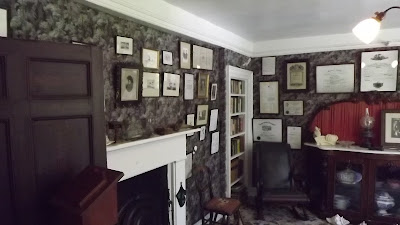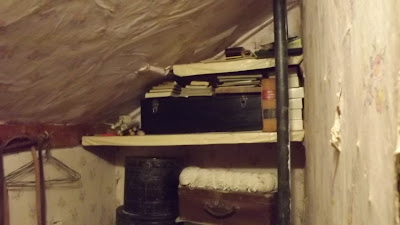Something I really wanted to talk about is Newfoundland generosity. I'm sure you've heard about it somewhere. As someone who's driven coast to coast of this country, many people say that Newfoundlanders are some of the kindest people they've ever met. I figured I would take some time to look at some of my favourite examples of Newfoundlanders and ponder why they can be such generous beings.
 |
Lanier Phillips in the 1940s. Exact year of photo
unknown. |
The first example that I can think about is Robert Chafe's play Oil and Water. You may remember that I Instagrammed a picture of my copy of the book a couple of weeks ago. It is still to this day my favourite play, possibly my favourite piece of literature, and as a Lit major who's almost done his third year of university, that is saying something. Oil and Water is based on a true story. The story starts in 1942 at Lawn Point, off the coast of Newfoundland. The USS Truxtun and USS Pollux ran aground and sank, killing hundreds. Oil coated the waters so bad that when an African-American man was pulled out of the water the Newfoundlanders had scrubbed his skin raw because they thought he was coated in oil like his Caucasian colleagues. The play tells the story of Lanier Phillips, the only African-American survivor of the disaster. This man lived in a time where people threw stones at him for being black. He was the only African-American survivor because his white coworkers forced the African-Americans to wait on the boats until they had all gotten into lifeboats.
 |
Lanier (Ryan Allen) being cared on by Violet and Ena (Petrina
Bromley and Alison Woolridge respectively). This production
was performed by Artistic Fraud. |
These Newfoundlanders had never seen a black man before and were baffled when the oil just wouldn't scrub off of the sailor's skin, when it was really just the colour of his skin. These people had never met a black man before and their instinct was to take him in as one of their own. They took him in, bathed him, clothed him, and nursed him back to health while also struggling to take care of each other, let alone some stranger. I find this heartbreaking and a great testimony to the Newfoundland spirit. I said it before but I actually got the pleasure to see one of Artistic Fraud's first showings of this great play, and it was an honour. It has a unique and beautiful score that is a very different blend of African American gospel and Newfoundland folk music. If you ever have the chance to see this show live, go and see it.
 |
"Plane people" staying in a school gym in Lewisporte. The
notebook that was passed around to create the scholarship
fund almost certainly went through this room. |
Another example that I find represents the Newfoundland spirit of generosity was Newfoundland's reaction to 9/11. As you most likely know, but I will do a brief refresher, back in 2001 two planes were hijacked and flown into the Twin Towers, killing many and devastating people all over the globe. Planes all over the place were ordered to land. When Gander, a town of 9,651 people in Newfoundland, heard, they immediately declared a state of emergency and opened their airport and doors to everyone they could fit. They went on to host almost 7,000 people from 95 different countries on 38 planes for the next five days. Since the hotels of the town owned roughly 500 rooms between them, churches, schools, and community centres from Gander and surrounding areas took in everyone they could fit. When that was not enough to hold everyone, the people of Gander and surrounding areas opened up their own homes as billets.
 |
Planes had to stay on the runways because there are not enough
terminals and parking space in the Gander airport for this many
planes of this great size. |
An amount of them were sent on busses to Lewisporte, as they all couldn't fit in Gander. A story about that that inspires me is that the people housed in Lewisporte were so grateful that they offered the locals money. Since none of them would take it, the "plane people", as the locals called them, passed around a notebook writing down their name and how much they would donate. This money went to create a scholarship fund for the children of Lewisporte. By the end of their stay, they had raised $15,000 for the children of Lewisporte. One of the plane people who worked with a group that creates scholarship funds used this money to create more money for the scholarship fund. In the past sixteen years the fund has created around $2,000,000 and has helped hundreds of students through university and is still growing. It's beautiful to see that the natural response to generosity is generosity and that people of such different backgrounds can come together and do such great things for each other.
 |
The ad design for Come From Away. This show tells the
story of the "plane people" and those who took them in. |
This story has gone on to inspire the musical Come From Away, a musical that tells the story of the plane people and those who took them in. This musical has won numerous awards, including a Tony, which is a major accomplishment, and is now on Broadway. I haven't seen it myself but I have heard the soundtrack and it is outstanding.
To do a bit of research on the statistics of Newfoundland generosity, I found out that, according to Statistics Canada in 2013, Newfoundland and Labrador as a province has the highest percentage of people who donate to charities, ranking in at 87 percent. Apparently Newfoundland and Labrador has been the highest province in that statistic in every study since 2004. While I can look at facts and studies until I'm blue in the face, I would like to offer up why I think Newfoundlanders are so generous.
Since the beginning of Newfoundland's founding and initial European settlement, Newfoundland has always been a group of small towns. When you go into a small town here in Newfoundland, everybody knows everybody and it's like family. We've never really been a wealthy island and so Newfoundlanders have survived for centuries not by fighting their way to the top but by carrying each other as high as they can. People survived by coming together and helping each other through their problems and struggles. Newfoundland has been hit by famines, tsunamis, wars, and St. John's, our biggest city, has burnt down five times. When you google "The Great Fire of St. John's" it responds with "pfft, which one?" I feel that this generosity roots from the fact that we have struggled together through many challenges and disasters and it is that bond of camaraderie that holds us all together. Can I say that with certainty? Not really. Can I say that this is my educated guess? Definitely. All I have to do is go to the local Foodland to find a good conversation with a complete stranger about just about anything. As someone who has lived in four different provinces and have visited the rest on several occasions each, I can say that Newfoundland and maybe one or two others are the only ones that I can consistently do that in.
But yeah, that's it for this blog. I want to end by asking you what you think could be a factor as to why Newfoundlanders often have an innate sense of generosity. Feel free to post your ideas in the comments as I would love to hear what you all think



 The three pictures below are of remnants of graves. When you go there you can look at a logbook they had of people who had died there. It was both interesting and witty as they had often spoke in riddles. One person had "died of thought", which refers to how the man had killed someone in England, hopped on a boat, and went to the New World in hopes of escaping. He presumable died either of the stress of guilt or that he may have killed himself.
The three pictures below are of remnants of graves. When you go there you can look at a logbook they had of people who had died there. It was both interesting and witty as they had often spoke in riddles. One person had "died of thought", which refers to how the man had killed someone in England, hopped on a boat, and went to the New World in hopes of escaping. He presumable died either of the stress of guilt or that he may have killed himself.





























































































